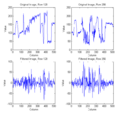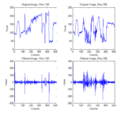Create the page "Filter" on this wiki! See also the search results found.
- ...D in the circle is how many zeros we fill between samples and the Low Pass Filter removes the extraneous copies of the signal beyond W/D shown in the output *So, intuitively, we want to use an LPF (low pass filter) to "remove" these high frequency spikes.5 KB (847 words) - 11:54, 21 September 2012
- If we imagine that our slit aperture can be thought of as a spatial filter that only passes light through the slit and blocks light everywhere else, t2 KB (286 words) - 10:19, 23 September 2009
- *To filter this out, we can apply a low-pass filter with a cutoff frequency of around 2000 Hz. *So adding a high pass filter should remove the bear's voice completely.5 KB (822 words) - 11:54, 21 September 2012
- Two basic filters used are 1> '''Average Filter''' == '''Average Filter''' ==3 KB (426 words) - 06:03, 14 October 2009

File:Rheapagepic.jpg A smooth image is obtained by applying the average filter as seen in the above figure.In case of the edge detected image, a compariso(1,366 × 670 (84 KB)) - 15:31, 13 October 2009- title('Image using Average Filter');782 B (107 words) - 06:01, 14 October 2009
- title('Image using Average Filter');787 B (108 words) - 06:06, 14 October 2009
- ...er:mboutin|Prof. Boutin]]: graph of the magnitude of the DFT of a windowed filter= Consider the ideal low-pass filter1 KB (212 words) - 11:50, 24 October 2011
- The end result after modeling is a transfer function that is an all-pole filter with a gain and a time delay. As noted above, the transfer function is usually an all-pole filter. We can observe what the resonances, or formants, are just by looking at t5 KB (841 words) - 15:26, 10 April 2013
- periodic filter phoneme - Generally, the vocal tract transfer function is an all-pole filter2 KB (390 words) - 07:46, 14 November 2011
- ...the series for tons of translations and dilations, uses a faster approach: filter banks. ==Multi-Resoltion Analysis using Filter Banks==10 KB (1,646 words) - 11:26, 18 March 2013
- The following pictures show the original image (Lena), the image of the filter, and the filtered image (done with conv2). Note that the FFT2 are plotted a ...e filter = 1/16*[1 2 1; 2 4 2; 1 2 1], commonly referred to as an "average filter":'''</u>8 KB (1,397 words) - 11:23, 18 March 2013
- periodic filter phoneme - Generally, the vocal tract transfer function is an all-pole filter2 KB (387 words) - 07:47, 14 November 2011
- Plot of the frequency response of the average filter: Plot of the frequency response of the filter:1 KB (163 words) - 12:50, 26 November 2014

File:Filter1 image.png Filter 1 Image (2X3)(981 × 538 (217 KB)) - 17:53, 25 November 2009
File:Filter2 image.png Filter 2 (2X3 panel).(1,280 × 702 (317 KB)) - 13:42, 25 November 2009
File:Filter3 image.png Filter 3 (2X3 panel).(1,280 × 702 (310 KB)) - 13:43, 25 November 2009
File:Filter4 image.png Filter 4 image (2X3 panel). Created November 25, 2009 for ECE 438, Ryan Scheidt.(1,280 × 702 (290 KB)) - 13:50, 25 November 2009
File:Filter5 image.png Filter 5 image (2X3 panel). Created November 25, 2009 for ECE 438, Ryan Scheidt.(1,280 × 702 (299 KB)) - 13:58, 25 November 2009
File:MeshFiltered.png Filter 1 mesh.(1,079 × 648 (198 KB)) - 18:17, 25 November 2009
File:Filter7.png Filter 7 = [-1 -1 -1; 2 2 2; -1 -1 -1](1,010 × 566 (214 KB)) - 09:39, 26 November 2009
File:Filter7Rows.png Filter 7 = [-1 -1 -1; 2 2 2; -1 -1 -1]; rows 128 and 256 in image and filtered ima(617 × 589 (27 KB)) - 09:40, 26 November 2009
File:Filter8.png Filter 8 = [-1 2 -1; -1 2 -1; -1 2 -1](1,023 × 577 (207 KB)) - 09:41, 26 November 2009
File:Filter8Rows.png Filter 8 = [-1 2 -1; -1 2 -1; -1 2 -1]; rows 128 and 256 of image and filtered ima(618 × 588 (25 KB)) - 09:41, 26 November 2009- ...g how to handle the boundaries is as important as knowing how to apply the filter to the image (at least in the context of this course). -[[User:crtaylor|Ry945 B (155 words) - 17:55, 8 December 2009
- ...of some non-linear filters for face-enhancement, such as the Perona-Malik filter that preserve sharpness and details, whilst removing noise at the same time235 B (33 words) - 22:21, 6 December 2009
- ...though I got good grade on ECE301. And the second part is basically about filter. Before you take ECE438, I also recommend that you should figure out how to17 KB (3,004 words) - 08:11, 15 December 2011
- h(x,y) → filter FREE → filter image based only on pixels: {H, K, P}5 KB (811 words) - 16:19, 19 December 2009
- ...ion evolves into a great estimation method. The more I know about particle filter for object tracking, the more I get impressions about power of random sampl6 KB (884 words) - 16:26, 9 May 2010
- ...al ( this is of course easier said than done because we then have to use a filter of the appropriate length and so on, which means another two pages of math) ...h cut off frequencies that represented those weekly variations. A low pass filter is one that passes low frequency signals but attenuates signals that have f13 KB (2,348 words) - 13:25, 2 December 2011
- **[[Practice_Question_5_ECE438F10|Practice Question 5 (filter design)]]9 KB (1,221 words) - 11:00, 22 December 2014
- *Week 7-8: Filtering (Systems defined by Difference equations, Filter Design, DFT view of Filtering) ***Prof. Bouman's lecture notes on digital Filter design: [https://engineering.purdue.edu/~bouman/ece438/lecture/module_1/1.79 KB (1,331 words) - 07:15, 29 December 2010
- ...system is an all pole filter cascaded with a time delay. The poles of this filter determine the location of the local maxima of the voiced phonemes we pronou1 KB (151 words) - 12:53, 8 November 2010
- ...o get rid of aliases, what is the cutoff frequency of digital LPF(Low-Pass Filter)?}\,\!</math>2 KB (315 words) - 10:39, 11 November 2011
- ...ore, the cut-off frequency, <math>f_c</math> of the discrete-time low-pass filter (LPF) is <math>f_c=\frac{\pi}{L}</math>, in general.3 KB (467 words) - 19:52, 20 September 2010
- ...s relationship, we concluded that, under certain circumstances, a low-pass filter could be applied to this upsampling so to obtain the signal1 KB (220 words) - 16:07, 22 September 2010
- ...rder to get rid of aliasing, what is the cut-off frequency of the low pass filter? Explain your answer. Assume that the input signal X(f) and the continuous time filter H(f) are both band limited to 1/(2T).2 KB (373 words) - 10:41, 11 November 2011
- Thus, the cut-off frequency of the LP filter is <math>\frac{\pi}{L}</math>.666 B (121 words) - 12:21, 29 September 2010
- ...it affects the reasoning here). And finally sending it through a low pass filter, the "extra" rects get filtered out so when you end up with non-zero freque5 KB (778 words) - 09:11, 1 October 2010
- ...plies that the reconstructed signal <math>x_r(t)</math> is the output of a filter when we input the impulse train of <math>x(t)</math> with period <math>T</m ...math>\text{sinc}(t/T)</math>, whose frequency response is a ideal low-pass filter with the cut-off frequency of <math>1/(2T)</math>.4 KB (751 words) - 04:56, 2 October 2011
- Q2. Suppose that the LTI filter <math>h_1</math> satifies the following difference equation between input < Then, find the inverse LTI filter <math>h_2</math> of <math>h_1</math>, which satisfies the following relatio3 KB (462 words) - 10:42, 11 November 2011
- ...aracteristics (Filter A) and another filer with band-pass characteristics (Filter B). The behavior of these two filters will be further studied when we retur867 B (122 words) - 16:21, 8 October 2010
- ...at a specific low-pass filter (filter A) and a specific band-pass filter (filter B). We noticed the two different ways of writing the transfer function (as2 KB (393 words) - 07:25, 25 October 2010
- equation (moving average filter) :a. Find the impulse response h[n] for this filter. Is it of finite or infinite duration?4 KB (661 words) - 11:22, 30 October 2011
- Q1. Consider the following second order FIR filter with the two zeros on the unit circle as shown below. The transfer function for this filter is given by <math> H(z) = (1-e^{j\theta}z^{-1})(1-e^{-j\theta}z^{-1})=1-2\c3 KB (480 words) - 10:42, 11 November 2011
- d. If we further look at the frequency response of this filter, :therefore, when <math>\theta=\pi/2</math>, it is a bandstop filter.2 KB (437 words) - 12:00, 19 October 2010
- Today in the lecture, we continued talking about filters and filter design using the transfer function. It seems like many students find it dif1 KB (174 words) - 03:53, 21 October 2010
- ...y with period <math>2 \pi</math>. It is important to remember this for any filter in discrete-time. In the last part of the lecture, we saw how the heat equa *[[ECE_301_Fall_2007_mboutin_Filter_Types|Ideal filter types in continuous-time]]: do not forget to repeat periodically every <ma2 KB (260 words) - 12:42, 22 October 2010
- Topic: Filter Design Define a two-pole band-pass filter such that2 KB (322 words) - 13:00, 26 November 2013
- d. Determineif the filter represented by the difference equation is FIR or IIR. Give reasons for your3 KB (479 words) - 10:42, 11 November 2011

